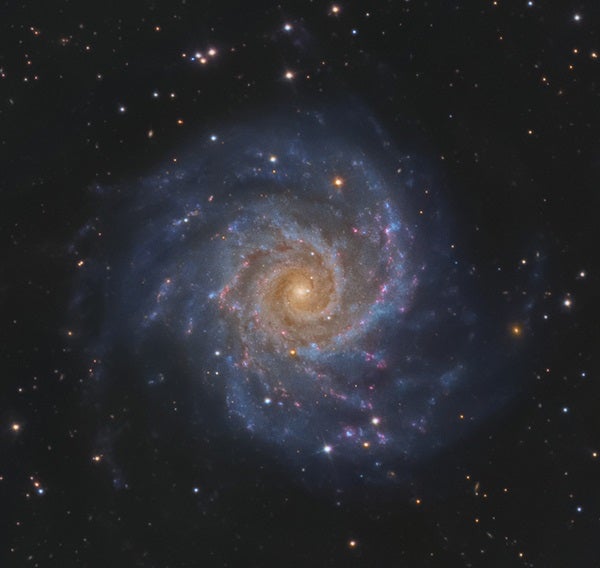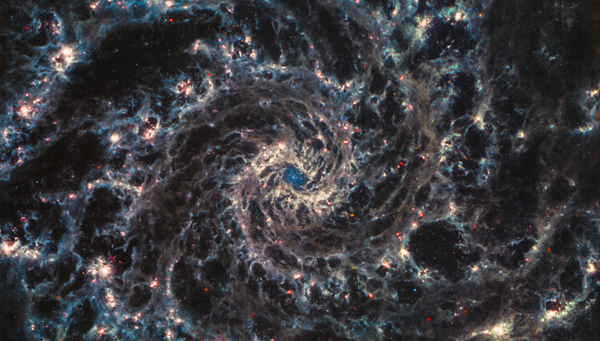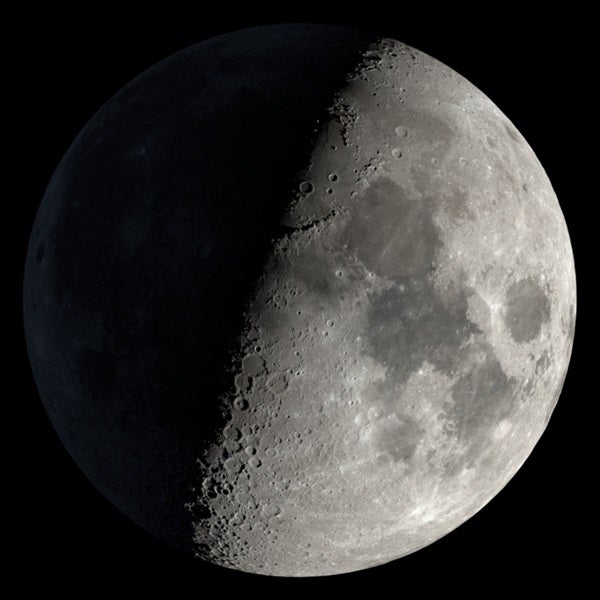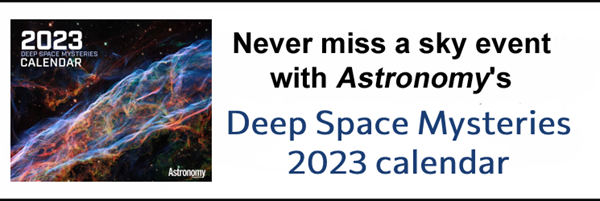Friday, October 28
Cygnus is still high in the west after dark, but the Swan is sinking toward the horizon as the hours pass. So, early this evening, whip out your binoculars or a small scope to view the large, loose open cluster M39, which sits in the northeastern region of the constellation about 9° (one and a half binocular fields) east-northeast from Deneb, the bright star marking the Swan’s tail.
Astronomy columnist Phil Harrington describes M39 through binoculars as “a tiny, triangular grouping of about two-dozen faint points.” If you can see it in a dark sky, he adds, the cluster appears “suspended in front of a blanket of faint stardust.” The young open cluster is between 200 million and 300 million years old; it spans some 32′ on the sky and glows at magnitude 4.6. In is a relatively small group, containing about 30 stars spread across about 7 light-years.
Because this cluster is so loose, you’ll want to stick to lower magnifications, as bumping up the power will chip away at its splendor.
Sunrise: 7:25 A.M.
Sunset: 6:02 P.M.
Moonrise: 11:13 A.M.
Moonset: 8:18 P.M.
Moon Phase: Waxing crescent (13%)
*Times for sunrise, sunset, moonrise, and moonset are given in local time from 40° N 90° W. The Moon’s illumination is given at 12 P.M. local time from the same location.
Saturday, October 29
The Moon reaches perigee, the closest point to Earth in its orbit around our planet, at 10:36 A.M. EDT. At that time, our satellite will sit 228,845 miles (368,290 kilometers) away.
Today is National Cat Day, so let’s spend the night with a celestial cat: Lynx. For many in the Northern Hemisphere, this constellation doesn’t get very high and may not ever fully clear the horizon. Fortunately, our target is in the portion of Lynx that’s above the horizon all night for the majority of U.S. observers.
We’re looking for the double star 19 Lyncis, which sits some 10.5° southwest of 3rd-magnitude Muscida, the nose of Ursa Major the Great Bear. The two stars in 19 Lyn sit nearly 15″ apart, making them easy to split through any telescope — and easy to enjoy, even for beginners or those with smaller instruments. They also make for a stunning pairing: One brighter, magnitude 5.6 star glowing bright yellow, beside a magnitude 6.5 star that shines a soft blue. Enjoy them together all evening long, though if you have buildings or light pollution on your northern horizon, waiting until later is better, as Lynx will rise higher and give you a clearer view.
More experienced observers with larger instruments can go for a bonus once the Moon sets: The galaxy cluster Abell 576 is a short 0.5° hop north-northwest of 19 Lyn.
Sunrise: 7:26 A.M.
Sunset: 6:01 P.M.
Moonrise: 12:23 P.M.
Moonset: 9:17 P.M.
Moon Phase: Waxing crescent (22%)
Sunday, October 30
Mars stands stationary against the background stars of Taurus at 7 A.M. EDT. Because it’s nearing opposition, Mars is visible during most of the time it’s dark overnight. You can opt to catch the Red Planet either in the hours before dawn if you’re an early riser, or after it clears the horizon by 9 P.M. local time if you’re a night owl.
Today, the Red Planet sits 2.7° north of 3rd-magnitude Alheka (Zeta [ζ] Tauri), which marks one of the Bull’s two horns. Through a telescope, the planet now appears 15″ across and is 93 percent lit, growing larger and brighter as we near its early December opposition date. If you’re familiar with — or ready to try out — high-speed video capture through your telescope, Mars is an excellent target. Around local midnight in the Midwest, the dark patch of Mare Sirenum is most prominent in the hemisphere facing Earth.
Sunrise: 7:27 A.M.
Sunset: 6:00 P.M.
Moonrise: 1:24 P.M.
Moonset: 10:25 P.M.
Moon Phase: Waxing crescent (32%)
Monday, October 31
Happy Halloween! Today, let’s enjoy a ghostly phantom in the sky — the Phantom Galaxy, that is.
Also cataloged as M74, this nearly face-on, grand design spiral is a sight to behold… if you can see it. It’s called the Phantom Galaxy because its large size — 11′ — spreads out its 9th-magnitude glow, giving it a low overall surface brightness and rendering it difficult to detect in light-polluted skies. That means your best chances of viewing it come either a few hours before dawn or late this evening, when there is no Moon in the sky. Opt for an extra-dark, spooky (but safe!) viewing location to up your chances, as well as a larger scope.
M74 is located in Pisces the Fish. It sits just less than 1.5° east-northeast of magnitude 3.6 Eta (η) Piscium. Also in Pisces right now is Jupiter — and the mighty gas giant is much easier to spot. Glowing at magnitude –2.8, the solar system’s biggest planet is easily visible with the naked eye. Through your telescope, it will stretch a whopping 48″ and shows off both atmospheric features and its large Galilean moons. Depending on when you look, you may see only a few of the four moons, or catch a transit as one of the satellites or its shadow crosses the face of Jupiter. The planet is located on the other side of Pisces from M74, about 9° east-southeast of the Circlet asterism.
Sunrise: 7:28 A.M.
Sunset: 5:59 P.M.
Moonrise: 2:14 P.M.
Moonset: 11:38 P.M.
Moon Phase: Waxing crescent (44%)
Tuesday, November 1
First Quarter Moon occurs at 2:37 A.M. EDT. Later in the day, the growing gibbous Moon passes 4° south of Saturn at 5 P.M. EDT. Not long after, the pair hang together in the darkening sky amid the stars of Capricornus. You’ll find them above the southern horizon after sunset, now nearly 5° apart as the Moon sits directly below the ringed planet. The two are visible all evening, skimming low through the sky.
Saturn’s soft magnitude 0.6 glow should still be visible with the naked eye; it sits within 1° of 4th-magnitude Iota (ι) Capricorni, which may be harder to pick out against the background light. Any telescope will really bring out the planet’s main feature: its stunning rings. Stretching nearly 40″ across, their northern face is still tilted toward Earth. Saturn’s largest and brightest moon, magnitude 8.5 Titan, is just over 1′ southeast of the planet tonight. Several smaller, fainter moons, including 10th-magnitude Dione, Rhea, and Tethys, cluster closer to the planet and rings.
Sunrise: 7:29 A.M.
Sunset: 5:58 P.M.
Moonrise: 2:54 P.M.
Moonset: —
Moon Phase: Waxing gibbous (55%)
Wednesday, November 2
Let’s return to Jupiter in Pisces this morning for a special sight as the large Galilean moon Callisto skims due north of the planet.
Of course, Callisto — like the other Galilean moons — orbits Jupiter. But the tilt of the moon’s orbit relative to Earth means it often appears to “miss” the planet entirely from our point of view as it crosses in front of or behind it. Jupiter in Pisces is still magnitude –2.8, simple to find and center in your telescope. The planet sets around 4 A.M. local time, however, so you will have to get up pretty early (or stay up pretty late on the 1st) to catch it. But it’s worth it to see the bright dot of Callisto slide from west to east right over the top of the planet, with plenty of apparent space between them! If you happen to miss the event, don’t worry — it will repeat later this month.
The three other Galilean moons are visible as well: Io sits far to the west, while Ganymede and Europa appear to the east.
Sunrise: 7:31 A.M.
Sunset: 5:56 P.M.
Moonrise: 3:27 P.M.
Moonset: 12:53 A.M.
Moon Phase: Waxing gibbous (66%)
Thursday, November 3
The Moon passes 1° south of asteroid 3 Juno at 4 A.M. EDT. However, if you want to catch the pair, you’ll again need to do it either early or late. They’re currently located in Aquarius, which sets about 2 A.M. local time. So, if you’re up around 1 A.M. this morning, you can find the Moon southwest of Juno for a short while before they disappear in the west.
If you prefer to view them in the evening sky — the better option for catching them through less turbulent air — they’re visible as soon as the sky is dark after sunset. Now, Aquarius is climbing in the southeast and the Moon sits near a nice curve of three 4th- to 5th-magnitude stars: Psi1 (ψ1), Psi2 (ψ2), and Psi3 (ψ3) Aquarii. The Moon is closest to Psi3, passing particularly near to this star between about 8 P.M. and 10 P.M. EDT.
Our satellite is now roughly 9° due east of Juno. The main-belt asteroid glows at magnitude 8.7, within reach of binoculars or a small scope. See if you can find it, even with the Moon’s background light. For a closer signpost, Juno is just 30′ northeast of a relatively bright 6th-magnitude field star.
Sunrise: 7:32 A.M.
Sunset: 5:55 P.M.
Moonrise: 3:55 P.M.
Moonset: 2:06 A.M.
Moon Phase: Waxing gibbous (76%)
Friday, November 4
The Moon now passes 3° south of Neptune at 4 A.M. EDT. The two are low in the west at that time, so you’ll want to observe them a few hours earlier if possible, before they sink too close to the horizon.
Like last night, both are in Aquarius, though Neptune is quite near the constellation’s northeastern border with Pisces. Around 2 A.M. EDT on the 4th (11 P.M. on the 3rd in the Pacific time zone), the planet and Moon are still 25° high. Magnitude 7.7 Neptune, which requires binoculars or a telescope, is just shy of 5° north-northeast of the Moon. It may be a bit challenging to pick out the distant planet’s dim, 2″-wide disk, but it’s worth a try. If you can’t quite seem to do it, just give the Moon a few days to pass out of the area and try again. Neptune sits between a pair of 7th-magnitude field stars that can serve as your guides all month.
The Moon passes 2° south of Jupiter at 4 P.M. EDT — we’ll check this pairing out in the evening sky in our column next week.
Sunrise: 7:33 A.M.
Sunset: 5:54 P.M.
Moonrise: 4:19 P.M.
Moonset: 3:16 A.M.
Moon Phase: Waxing gibbous (85%)













